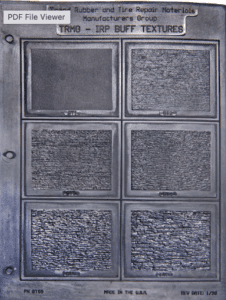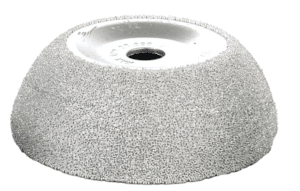Many factors will influence the adhesion strength of a tyre repair from the skill of the technicians and the cleanliness of the workshop to the choice of vulcanising system and the quality of repair materials. Here we look at the role of buff textures in tyre repair.
When building the repair it is important to finish the rubber sub-surface with a buff texture which is appropriate for the type and size of tyre and the area on it you are repairing.
The correct texture helps to optimise adhesion strength and ensure your repair is fit for purpose.
What texture do I need?
 The first step is to identify the appropriate texture for the tyre you are tackling. For example, OTR tyres need a much rougher buff texture than passenger.
The first step is to identify the appropriate texture for the tyre you are tackling. For example, OTR tyres need a much rougher buff texture than passenger.
A useful resource is the Tire Repair Materials Group (TRMG) buffing guide, last updated in 2020, which is available from TIA and TRIB. This is a rubber texture sheet featuring examples of the six industry approved buffing textures used when working on the tyre.
The rubber guide comes with a data sheet explaining when to use each texture, from the smoothest (BT1) for inside surfaces receiving chemical repairs right up to the exceptionally coarse BT6 which is no use for tyre repairs.
See below for an excerpt.
Which buffing rasp is right for the job?

A tyre repair technician builds knowledge over time to ensure they can select the correct buffing rasp and use it for the right length of time in order to create the perfect texture for the job.
Your tool manufacturer will also issue specific guidance as to which grit achieves which buffing texture. For example a smooth buff such as BT2 can be achieved with a fine grit 60 (170), whilst a coarse grit 16 (390) tool would be used to achieve BT4 or BT5.

Note, timing is crucial as an over buffed surface will compromise repair strength. It’s also vital not to burn the rubber surface during the buffing process.
Always ensure the buffed surface is completely free from loose material, dirt and any contaminates prior to continuing with the repair process.
Please get in touch if you have further questions about the role of buff textures in tyre repair or would like to speak to a member of our expert team.
Please note that buff textures and descriptions are for general guidance only. Always refer to your material supplier or manufacturer for specific advice and note that it is your responsibility to consult, and adhere to, all relevant guidelines and legislation – please refer to our tyre repair safety considerations and disclaimer.
